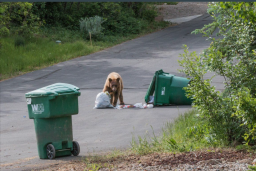Colorado’s bears seem to be out earlier in parts of the state and a bit bolder in others, wandering trails, city streets and even into homes or restaurants in search of easy food, experts say.
The reasons why vary from region to region. To the southwest, their natural food this time of year — nuts and berries — appear to be in short supply, so they’re on the lookout for quick meals, according to Bryan Peterson, executive director of Bear Smart Durango.
Or to the north, around Steamboat Springs, the bears seem to have lost their natural fear of humans, so they feel empowered to break into homes, garages and even restaurant patios more often than normal, Christy Bubenheim, of Colorado Parks and Wildlife, said.
Perhaps there are just more people around, hiking, camping and leaving food around, which attracts bears, Michelle Witte, nature education director of Nederland’s Wild Bear Nature Center, said.
Whatever the reason, Coloradans should be aware of the animals with whom they share the state and take precautions to keep themselves and the bears safe, the experts agree. Because while bears have attacked — and even killed — people in Colorado before, the vast majority of human-bear encounters actually end poorly for the bears.
“We’ve had to put down two bears in the last couple of weeks,” Bubenheim said. “Once they learn that behavior of going into a house repeatedly, it’s impossible to train it out of them.”
Between 2015 and 2021, Colorado Parks and Wildlife euthanized 775 bears and captured and relocated another 402, according to data provided by department spokesman Jason Clay.
The best way for people to minimize bear encounters, euthanizations and relocations is to keep easy food sources secure and to try and scare the animals away whenever they can, Bubenheim said.
Normally in the Durango area, bear activity ticks upward around mid-August, Peterson said. But the environment is “super dry” right now, meaning a lot of natural bear food isn’t as easy to come by. So the animals are on the move much earlier than normal, looking for whatever they can eat.
They’ll go after unsecured garbage cans, chicken coops or even sneak into homes if they can, he said.
“Most bears want to avoid people,” Peterson said. “But in these tough food times they take the risk and spend more time around people and homes because there’s more food there.”
Up north, in Routt County, Bubenheim said there’s more natural food around, but the bears will still go after easy meals humans leave out for them. That could be as simple as an unguarded birdfeeder but it could also mean busting through a first-floor window screen.
Earlier this month, a bear wandered into the patio at Sunpie’s Bistro, the Steamboat Pilot & Today reported, before heading into Aurum Food and Wine’s dining area. And last month another bear entered the lobby of a local resort after staff left a door open to catch a breeze, the Pilot reported. Bubenheim said the number of bear encounters are lower this year but the “significance” of the encounters is up, meaning “we’re having more bears getting into homes and causing more issues than just sightings.”
“It just seems like they’re a little more brazen this year,” she said.
To date, Clay said, people have reported about 722 bear “sightings and conflicts” this year. That’s down from 1,042 this time last year, 804 in 2020 and 903 in 2019. But there’s still time for that number to rise much further.
The “significance” of those encounters increasing, Bubenheim said, is likely because the black bears in the region were raised near people and they’re no longer afraid. Rather, they probably expect humans to take their pictures more than anything else.
“They’re like, ‘OK, this is cool, I don’t mind getting my picture taken,’” Bubenheim said.
People who encounter bears can still take pictures, Bubenheim said.
“But then scare the heck out of that bear,” she said.
That means honking your horn, yelling, throwing rocks and stretching out your arms to appear bigger, Bubenheim said. So long as you can do that from a safe distance.
Same thing if you’re out hiking or camping, Witte said. Clap, wave your arms and yell for the bear to go away.
“They’re big ‘ol scaredy cats and they’ll run away from that,” Witte said.
And with a little luck they’ll remember the experience and stay away in the future, Witte said. Kind of like training a dog.
People who live near bear populations should have locks on their trash cans and make sure ground-level doors and windows are secure, Bubenheim said. Screens aren’t enough to keep bears out.
“It’s been very warm and I’d love to sleep with my windows open,” Peterson said. “But I can’t. I live in real good bear habitat and I don’t want a bear in my home.”
Bird feeders and chicken coops also make easy targets, Peterson added.
People out hiking should make loud noises as they move along to scare the bears, Witte said. Talk, sing or even ring a bell. Animals will avoid those noises.
If you’re by yourself then you can sing aloud or clap your hands, Witte added. Don’t plug in headphones. Listen to your surroundings.
Campers should seal food in bear-safe containers or in a locked car, Witte said.
These sort of small behavioral changes from humans could lessen the chances of state officials having to capture and relocate or kill a bear, Witte said. And there’s no reason humans and bears can’t learn to live together safely and responsibly.
Source: Read Full Article


